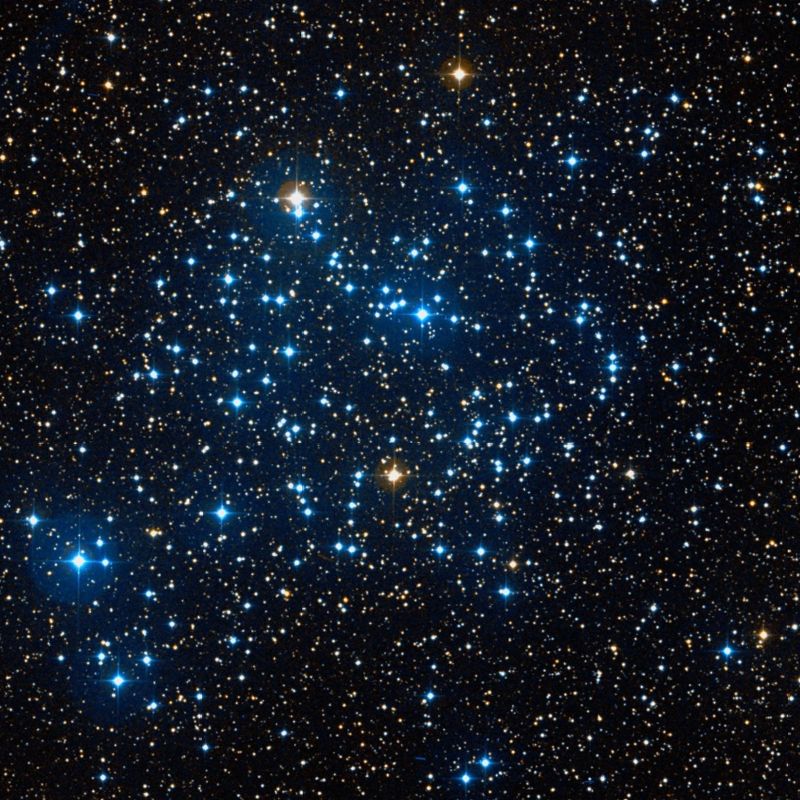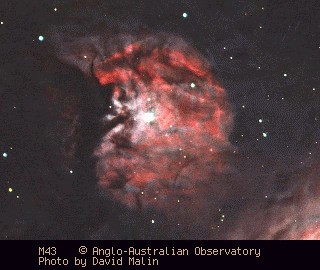



| Observer: | Tom Campbell |
| Location: | Iola, Kansas (Long: 95°30'W Lat: 37°55'N) |
| Equipment: | 8" Discovery DHQ dob |
| Eyepieces: | 2" 51.5mm Modified Plössl, 1.25" Plössls - 25mm (49x), 15mm (81x), 10mm (122x), 6.5mm (188x), 4mm (305x) |
| Filters: | Lumicon O-III |
| Time: | 7:15pm - 8:30pm CST |
| Transparency: | Mostly clear, but with thin cloud banks moving through. (7/10) |
| Seeing: | Fair (6/10) |
| Weather: | Temperatures in the mid-to-low 40s. There was little or no wind. |

I can't believe it has been over two months since my last observing session! Between sickness, cold weather, bright moonlight, and clouds, it doesn't take long for the time to pass by. I was anxious to get back into the observing habit again, and during Winter, you take your starry nights however you can get them, especially when the temperature is above freezing.
| M 1 (Crab Nebula) | Taurus | Supernova Remnant | 7:15pm CST |
| NGC 1952 | RA: 0534.5 | Dec: +2201 | Mag: 8.4 |
 |
At 49x, it's fairly faint, but definitely visible as a dim, blurry smudge of irregular shape. 122x makes it appear larger and noticeably oblong. Next to it lies the mag. 6.9 star TYC 1310-1195-1, which makes the job of focusing much easier. The nebulosity was fairly uniform, except for fading out a bit near the edges. At times, I thought I could start to make out tendrils near the edge of the nebula, but I'm sure it was my mind imagining it. At times like these, I wish I hadn't seen the object before I observed it. |
||
| M 35 | Gemini | Open Cluster | 7:30pm CST |
| NGC 2168 | RA: 0608.9 | Dec: +2420 | Mag: 5.1 |
 |
At 49x, the cluster takes up the entire field of view. The most noticeable feature is an arc of stars on one side, dipping toward the center. At either end of the arc are brighter stars. Also, in the center of the cluster is a dark area which is mostly devoid of stars. All told, there are probably in the neighborhood of 50-60 stars visible in the cluster. I looked at this cluster last year when I first got my telescope, but Gemini was setting rather early in the evening and the view wasn't nearly as spectacular. Just for fun, I put in my 51.5mm eyepiece (24x) for a low-power view. The cluster fits nicely into the field of view, with plenty of space around all sides. The cluster is nearly round, with a triangular hole missing in the center. However, many of the stars are no longer visible because of the smaller size, so the cluster doesn't look quite as impressive. |
||
| NGC 2158 | Gemini | Open Cluster | 7:40pm CST |
| RA: 0607.5 | Dec: +2406 | Mag: 8.6 | |
 |
This small cluster is visible as a faint smudge off to one side of M35. At 49x, it resembles a nebula. The view is a bit better at 88x. There is a nearby star much brighter than any of the stars in the cluster. It seemed to be right on the edge of resolving into individual stars, but couldn't quite make it. With averted vision, it had a roughly triangular shape. |
||
| A bank of clouds moved in, covering most of the sky. A few of the brighter stars still shone through, but I decided to go inside for a bit and try to wait it out. I was glad for the excuse to warm up a bit, as well. After about half an hour, the skies had cleared somewhat. Clouds were still rolling through, but they were much thinner and there was more clear sky between them. | |||
| M 42 (Orion Nebula) | Orion | Bright Nebula | 8:15pm CST |
| NGC 1976 | RA: 0535.4 | Dec: -0527 | Mag: 4.0 |
 |
This is a beautiful green color in my telescope. At 49x, it fits nicely in the field of view. Two large "wings" of nebulosity emanate from the Trapezium outward, like a great green bird. Below the Trapezium is a brighter patch of nebulosity. At the "head" of the bird is a cone-shaped patch of darkness which ends at the Trapezium. The four main stars of the Trapezium can easily be detected, even at 49x. Intermittent clouds caused the nebulosity to fade in and out. In moments of transparency, the nebula is rich in both color and detail. At 88x, in moments of clear skies, the Orion Nebula begins to take on some texture, with cloudlike billows appearing out of the midst of dark and light regions. |
||
| M 43 | Orion | Bright Nebula | 8:25pm CST |
| NGC 1982 | RA: 0535.6 | Dec: -0516 | Mag: 9.0 |
 |
This appears rather faint and insignificant, compared to its larger brother. It is a puffy wisp around the mag. 6.9 star n Orionis. A large black band separates this nebula from M42. |
||
About this time, one of my neighbors turned on her porchlight, nearly blinding me. I thought about moving my telescope behind my shed, but the unstable skies made me decide to give up for the night. Even though my session was short, I had some quality time under the stars.